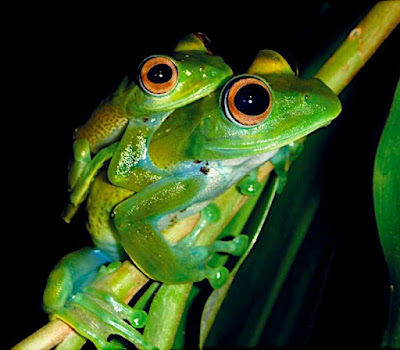 |
| Boophis asquithi Glaw, Köhler, Crottini, Gehring, Prötzel, Randriamanana, Andreone & Vences, 2021 Salamandra. 57(3); |
Abstract
New genetic, bioacoustic and morphological data on green-coloured Boophis treefrogs from eastern Madagascar reveal an additional level of cryptic diversity in these frogs. Two candidate species, Boophis sp. Ca36 and Ca37, are closely related to each other and to B. sandrae, with uncorrected pairwise distances in the mitochondrial 16S rRNA gene as low as 2.2% between some individuals. However, the three lineages show full concordance between differentiation in the 16S and the nuclear-encoded SACS gene, despite confirmed syntopy of B. sandrae and B. sp. Ca37 in the Ranomafana region, and probable syntopy of B. sp. Ca36 and B. sp. Ca37 in the Andasibe region. Most likely, these lineages are also divergent in advertisement calls, but the available recordings cannot be reliably assigned to either of them. Based on new material collected from various new sites, we here formally name B. sp. Ca36 as new species Boophis asquithi sp. n., and suggest targeted fieldwork on calls and larval stages to allow for a complete and fully conclusive taxonomic revision of this species complex. The example of these frogs illustrates how continued underestimation of cryptic diversity in anurans can lead to incorrect assignment of specimens, and leads us to emphasize the importance of designating as name-bearing types (holotypes) of anurans only individuals whose identity is unambiguous by genetic data or, at least, call recordings reliably assignable to the type specimen.
Key words. Amphibia, Anura, Mantellidae, Boophis luteus species group, Boophis elenae, Boophis sandrae, Boophis asquithi sp. n., Madagascar, cryptic species.
Etymology. The specific name is dedicated to Mr. John
David Asquith, in recognition of his support of biodiversity research and nature conservation through the BIOPAT
initiative.
Natural history. Calls probably emitted by B. asquithi were
sometimes heard from higher positions in trees around
Andasibe in the rainy season, but unfortunately, call recordings are not available of any voucher specimen. The genetically unconfirmed male ZFMK 60027 was calling on
15 January 1995 (at night) from vegetation ca 3 m above the
ground. The vocal sac was relatively large, but did not inflate
during the vocalization, suggesting that the vocalizations
were possibly produced both during expiration and inspiration. The couple from near Tarzanville (Fig. 8) was found
in axillary amplexus along a small river in the evening of
12 April 2010. The female had numerous yellowish eggs in
its body cavity. A second couple in axillary amplexus probably assignable to this species was found inactive (sleeping)
during the day along the road. ZSM 130/2016 was sitting at
night on a leaf in the vegetation along the road, less than
1 m above the ground and did not vocalize.
Frank Glaw, Jörn Köhler, Angelica Crottini, Philip-Sebastian Gehring, David Prötzel, Lalaina Randriamanana, Franco Andreone and Miguel Vences. 2021. An Additional Level of Cryptic Diversity: A New Green-coloured Malagasy Treefrog of the Boophis luteus Species Group. Salamandra. 57(3); 295-308.






